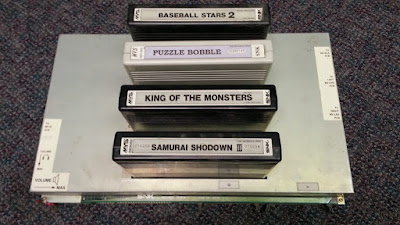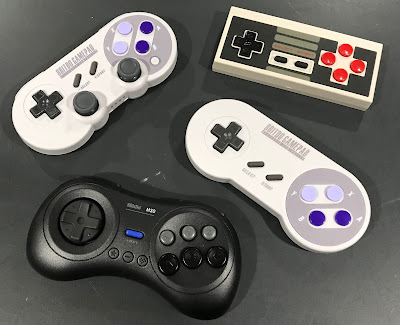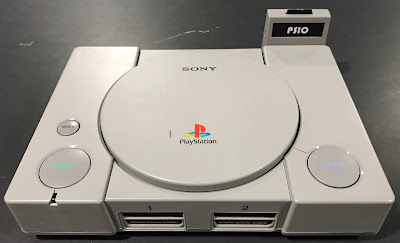This past year saw a flurry of tweaks and replacing of consoles and switches. Since I had posted about my console setup at the start of 2018 and 2016, I figured I should continue to note the changes. Notable is the increasing presence of optical drive emulators (ODE) and field programmable gate array (FPGA) consoles. Here goes.
Core Grafx II with Super SD System 3 (SSD3)
The Core Grafx was a revised PC-Engine, which included composite video out, which was an upgrade over the original PC-Engine's RF-video output. This is a moot point, as the attached SSD3 unit outputs RGB video. For those of you who don't know what the SSD3 is, here is an overview. The gist of it is that it allows for playing CD-ROM games and Hu-card games from an SD card. This is different from an Everdrive as it allows for the playback of CD-ROMS where Everdrives only play cartridge games.
Playstation 2 with HDD and Free McBoot
The Playstation 2 generation represents one of the largest leaps in technological power that I can remember. The original Playstation, while revolutionary with its 3D rendering, left a lot to be desired in hindsight. The PS2 exceed my expectations, and made 3D games fun. The FreeMcBoot mod allows for playing games that have been downloaded onto the internal hard disk drive. Getting the games onto the hard drive is a tremendous pain, but once they are there, things run smoothly.
I have two Sega Saturns hooded up simultaneously (actually, I have 3 as one is connected via HD Retrovision cables to a Sony Trinitron elsewhere). The Rhea is an optical disc drive emulator that replaces the laser, and gets game information from an SD card. Not willing to ignore my genuine Saturn game collection, I have my translucent "This is Cool" model 2 hooked up alongside it. 95% of my Saturn library are Japanese imports, so I felt a Japanese console was fitting. This seem a bit irrational, but what can you do. I have an action replay cart to bypass region locking, but Japanese startup screen is so much cooler.
Analogue Mega SG
Made by Analogue, known for its near-flawless implementation of FPGA technology to simulate retro hardware, the Mega SG is a dream come true for hardcore Sega Genesis fans. There have been droves of Genesis clones to date, but this is the right way to do it. The crystal clear pixel generation makes the Genesis pop off the screen, and the sound emulation is the closest that ever been produced. Since there is no emulation layer, flashcarts like the Everdrive are compatible. It is even compatible with the Sega CD via the expansion slot. Unfortunately, the 32X is not compatible as it requires mixing of the analog graphics from the Genesis, and this being an all digital unit does not allow for it. I wasn't a huge fan of the 32X library, so I'm not as irked as others. I do have a Sega CD model 2, but I don't have it hooked up as I don't think it is worth the space, and the when attached, the overall appearance is wonky and misshapen. Recently there was an unofficial jailbreak firmware released, which allows for playing games directly from an SD card, forgoing the need for an Everdrive.
CBox Consolized Neo Geo MVS
The CBox is one of several methods to play actual Neo Geo hardware at home. It contains an actual Mulit Video System (MVS) board that is found in the Neo Geo arcade cabinets. Since the arcade cabinets played MVS cartridges, so can I. Some added features are multiple video options (RGB, S-video, and component), the Universe Bios preinstalled, and Sega Saturn controller compatibility. Collecting Neo Geo carts is not something to take lightly, but the 161 game multicart eases that need.
Sega Dreamcast with GDEMU
Like the Rhea for Saturn, the GDEMU is an optical disc drive emulator that plays games from an SD card. Even though the Dreamcast can play burned game discs with no fuss, the disc laser assembly and motor are prone to breaking down. A solid state option like GDEMU forgoes moving parts, and extends the life of the console in addition to the providing the convenience of SD card rom loading.
Playstation with PSIO
The PSIO is another rom loading solution, but this one communicates through the rear parallel port, and does not replace the optical drive. This means original disc games can be still be played. This is a fantastic mod in that regard.
Gamecube
This gamecube doesn't have anything too special going on, other than the attached Gameboy Player adapter and genuine Nintendo component cables. I am considering selling the cables (which are fairly rare and valuable) and switching to one of the newer HDMI solutions. I don't play it all that much to be honest.
PC-Engine Duo component modded
The PC-Engine Duo was the combined unit of the Super CD Rom drive and PC-Engine. Originally, these units would have to be purchased separately, and joined by an interface unit (shaped like a briefcase), and required various system cards. The Duo unit foregoes the need for those extras, and plays everything (except the arcade card games) without a fuss. I went with the Japanese Duo over the American Turbo Duo since the Japanese library had more games released. The component mod was very necessary as the video output was composite by default. In hindsight, I should have opted for RGB as that would reduce the number of types of video connections I have goin on under my TV.
RetroUSB AVS
The Advanced Video System is named as an homage to the original proposed name of the Nintendo Entertainment System prior to its American launch back in the 80's. It is an FPGA clone console, outputting 720p visuals with stunning clarity. There are slots for both American carts and Japanese Famicom carts, so a 60 to 72 pin converter cart is not necessary to play imports. Everdrives are compatible as well, which is no surprise given that it is FPGA. It has four controller ports, for immediate four-player parties with compatible games. It is compatible with the the Famicom Disk System through an expansion port, for those who are interested.
Analogue Super NT
This is the FPGA Super Nintendo clone console. Just as Analogue's Mega SG nailed the Genesis nuances, the Super NT conquered the Super Nintendo's quirks: compatibility with special chip carts, to be specific. Everdrives are compatible, to no surprise. An unofficial firmware jailbreaks was released for this console as well, allowing for SD card game loading.
Playstation 3
It's probably my least played console that is hooked up. Its Ok, but the game library doesn't do much for me. Most of my games are collections of PS2 games remastered in HD. I do like that it is region free.
Playstation 4
I like the PS4 library better than that of the PS3, due to the increased number of indie and retro-aesthetics.
Switch
Like the PS4, retro game collections are the bulk of my small collection. I take it on trips to play in hotels and whatnot, but otherwise it is docked at home.
Raspberry Pi
Mine is housed in a RetroFlag Sega Genesis case, with safe shutdown mod. It is a little redundant I know, but currently it is the only way I can play arcade games on my TV.
Connectivity
My consoles are connected in the following manner:
Core Grafx w/ SSD3 --> GScartsw --> OSSC --> HDMI switch --> TV
Sega Saturn w/ Rhea --> GScartsw --> OSSC --> HDMI switch --> TV
Sega Saturn (Japanese) --> GScartsw --> OSSC --> HDMI switch --> TV
Playstation 2 --> GScartsw --> OSSC --> HDMI switch --> TV
Playstation w/PSIO --> GScartsw --> OSSC --> HDMI switch --> TV
Gamecube --> component switch --> OSSC --> HDMI switch --> TV
PC Engine Duo --> component switch --> OSSC --> HDMI switch --> TV
CBox Consolized MVS --> component switch --> OSSC --> HDMI switch --> TV
Dreamcast w/ GDEMU --> VGA cord --> OSSC --> HDMI switch --> TV
Mega SG --> HDMI switch --> TV
Super NT --> HDMI switch --> TV
AVS --> HDMI switch --> TV
PS4 --> HDMI switch --> TV
PS3 --> HDMI switch --> TV
Switch --> HDMI switch --> TV
Raspberry Pi --> HDMI switch --> TV
Means of connectivity:
GScartsw automatic 8 port RGB scart switcher
Impact Acoustics powered component switcher
Open Source Scan Converter
Monoprice 8port enhanced HDMI switcher
Even with all of these updated consoles, I still have my originals stowed away, not ready to abandon them. There may be a day when I want to hook up the originals again. From a game collection standpoint, I have started to focus the collection on only quality games that I truly want and/or know I will play. I kept a few stinkers if there was strong nostalgia for them, but for the most part the filler has been moving out, sold on eBay to finance the hardware changes. I have had an easier time letting go of the extra games since Everdrives and ODE devices have been acquired.
So that's what I currently have hooked up. How about you? Do you opt to have multiples of the same system connected? Are there consoles that you don't feel that you need to have connected? I'm always interested in seeing what other peoples' setups look like.






















































